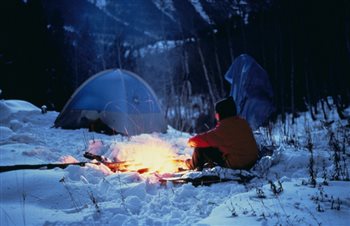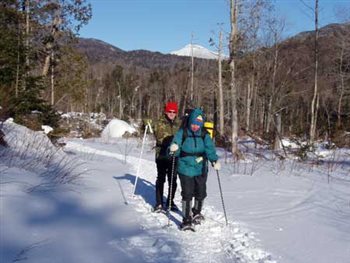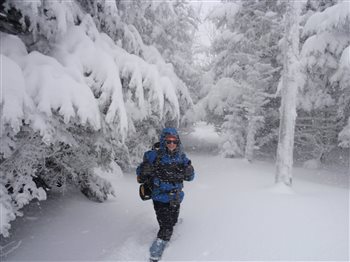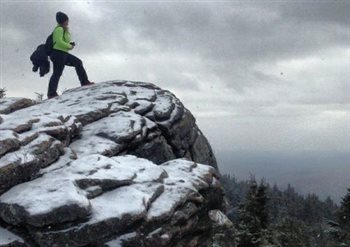Hiking is an excellent and entertaining outdoor activity that provides you with an opportunity not just to enjoy nature’s landscapes and sceneries but also to maintain health and conditioning. The great thing about this activity is that it can be done whenever and wherever you want despite the terrain.
On the other hand, contrary to hiking throughout a warm season, there are a few hitches of winter hiking that enthusiasts should know to enjoy the snowy landscapes and frosty air in its entirety. If you think that the weather is scary, but the trail appears so beautiful that you just can’t resist the hiking temptation, then you will surely find great use in the winter hiking tips in this post.
By following these guidelines, you prepare for the winter adventure you’ve planned for a very long time and make it a pleasant, healthy and entertaining experience.
1. Layer

You need garments that can keep you warm and cozy during times of inactivity. The odds are that you will generate plenty of heat throughout that backcountry journey, but it will be harder for you to maintain a constant warm temperature once you’ve stopped moving.
Layer up. For the base layer, use a polyester thermal underclothing. Get breathable fleece to stop the build-up of perspiration during exertion. If you like natural fibers, then select wool-fleece blends and merino wool that provide the wool’s warmth without the unnecessary discomforts.
Bring a neck gaiter or scarf that you can remove and wear easily to normalize body temperature; also take a light jacket that’s both breathable and waterproof. Moreover, layering can keep your feet and head warm. Wool or fleece stocking caps are windproof when masked with a removable hood. Leave cotton socks.
Rather, choose wool (and merino wool will not be itchy) or hiking-for-designed wicking polyester socks. Boots do not need to be costly, but they must be water-repellent or waterproof, especially if you want to hike through the snow.
When you stop activity, just put the layers back instantly. A parka or down jacket can be strapped on to your sled’s outside so you can wear it each time you stop to remain warm. I once brought two weighted hats – a light wool trekking hat along with a heavy hat for easy walking and resting.
I adored my comfortable aviator hat that I wear every time we stopped. It truly felt so great to get the head warm.
2. Bring Snow Equipment
Even though you have been on the route numerous times all through the summer, it could look rather different once the snow covers up the sites you are used to seeing. Just bring a GPS device (or any hiking device with GPS) and a decent area map in case you get lost, and ensure that everybody in the group brings one too.
Decide on the route you will take together as one group, and be ready to re-assess the circumstances if the route does not look safe or secure. It is crucial that you have knowledge on map reading. If you have never utilized one before, or require a refresher, just check articles on how to read a topographical map.
If you get lost, then don’t panic. Study your GPS unit and map calmly to see your location and attempt to work out where you have to go. Trace your steps and tracks until you can identify where you’re located on the map. If you are separated from the group, be loud or blow a whistle so they can hear or call to you.
3. Scout Out the Campsite

When you are ready to relax after the first day of hiking, simply take the time and effort to assess your would-be camping site. First of all, you do not want to stay in an area where an avalanche might take place, such as below a mountain or hill covered in thick snow.
Not being under trees is ideal too, as the snow’s heavyweight can make them break unexpectedly. Winter has a tendency to bring more wind than the summer season, so make certain your location is protected from the wind.
You will need to get warm when you are at the campsite, especially that you will not be moving much. And if possible, position the campsite in a way that the sun rises in the morning to warm you up quickly.
4. Take a Skilled/Experienced Friend

Hiking with pals is the way to go, especially during the winter season. It isn’t just more enjoyable to share the experience and adventure with others, but it is also safer and more secure to be with the group. An experienced companion can aid you in selecting gear, utilizing snowshoes or crampons, and identifying hazardous conditions.
Moreover, avid winter hikers frequently have additional gloves, goggles, and hiking poles lying around which you could use to complete your packing list. Make sure that the folks you leave behind know where you are heading.
5. Make Cocoa or Tea

It is important to bring adequate water when hiking during the winter because dehydration is a very common problem.
Add a few comforts to the trip by making cocoa, coffee, or tea in a thermos, or a light handy stove.
A hot drink can warm the group up and offer a nice rest from the hike.
And if your water is at room temperature, it is less likely that you will feel the chill, and it’ll boil faster.
6. Invest in Excellent Gear

While packing lists aren’t just the same, there are a few basic things that winter hikers should be ready to purchase. The majority of avid winter hikers buy the following gears: snowshoes or crampons, waterproof jacket and pants, waterproof boots, knee-high gaiters, an insulated jacket, hiking poles, a lightweight backpack, a camp stove, gloves and hats, and wrap-around sunglasses or goggles.
While it is enticing to take the inexpensive route and acquire sub-par equipment, I suggest coupons and end-of-season sales instead. There are many closeout items online that you can explore for different hiking gear you may want to bring.
Also, you may want to bring a water bottle with you since water may be scarce even during the winter. Choose water bottles that are built for the winter.
And it can be costly when you are just getting started, however, most of the equipment you select can be handy even for the summer season.
7. Check the Weather Conditions

Winter weather can be extremely harsh. Thus it’s important to assess the weather forecast and prepare yourself for any changes in the environment. Note that such conditions include not only the temperature but the wind speed, precipitation and daylight hours as well.
If you are acquainted with hiking during the summer, then you should know that the winter hiking experience is completely different and can be rather dangerous due to thick snow – the risk range from snow storms and avalanches.
Even if you’re not heading towards an elevated mountain and go hiking by yourself in the hill-country, it’s still advisable to check the weather conditions because hiking in a mountainous terrain can be risky as well as challenging in snowy and icy weather.
Also take note that hiking in excellent weather, when it’s sunny, and there’s no wind, will be more comfortable and enjoyable experience for you. When it comes to daylight, it’s also essential to know that daytime hours in the winter are much shorter than in the summer, and darkness can blow you with its abrupt arrival when you’re still strolling in the woods.
Thus, it’s better to begin your hike early in the morning because it allows you to make the most use of daylight and perhaps return home before the sun sets.
8. Learn How to Navigate

Because of shorter daytime hours and possible inclement weather conditions, it’s easier to lose your way while hiking in the winter than in the summer season. Furthermore, winter frequently buries the terrains underneath the snow; they all begin to look the same.
Because of this, it might be difficult for hikers to get back on track in snowy landscapes, particularly if it’s an unfamiliar spot.
Navigate the winter terrain. If you’re lost in these conditions, the most excellent option is to utilize a compass, GPS, or map for navigation. And if you decided to go on a serious and extensive winter hiking journey, it is worth taking a wilderness navigation course, practicing your navigation abilities before heading to the wild.
Winter Camping on Vermont’s Long Trail
This guy’s gonna show you how it’s done!
Conclusion
With these guidelines, you should be ready for anything that would confront you in the winter while hiking. Following them thoroughly and preparing yourself for what’s coming will make your hiking experience an entertaining and unforgettable adventure.
And take note that winter time is an ideal time for getting closer to mother nature, discovering terrains, and conquering frontiers. Don’t miss this opportunity!

0 comments